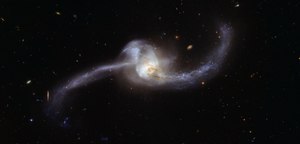NGC 2623
| Galaxie NGC 2623 | |
|---|---|
(c) ESA/Hubble, CC BY 4.0 | |
| Die Doppelgalaxie NGC 2623 aufgenommen vom Hubble-Weltraumteleskop | |
| AladinLite | |
| Sternbild | Krebs |
| Position Äquinoktium: J2000.0, Epoche: J2000.0 | |
| Rektaszension | 08h 38m 24,1s[1] |
| Deklination | +25° 45′ 17″[1] |
| Erscheinungsbild | |
| Morphologischer Typ | Pec;LINER;LIRG Sy2[1] |
| Helligkeit (visuell) | 13,2 mag[2] |
| Helligkeit (B-Band) | 14,0 mag[2] |
| Winkelausdehnung | 2,4′ × 0,7′[2] |
| Positionswinkel | 60°[2] |
| Flächenhelligkeit | 13,6 mag/arcmin²[2] |
| Physikalische Daten | |
| Rotverschiebung | 0,018509 ± 0,000003[1] |
| Radialgeschwindigkeit | (5549 ± 1) km/s[1] |
| Hubbledistanz H0 = 73 km/(s • Mpc) | (245 ± 17) · 106 Lj (75,1 ± 5,3) Mpc [1] |
| Durchmesser | 170.000 Lj[3][4] |
| Geschichte | |
| Entdeckung | Édouard Jean-Marie Stephan |
| Entdeckungsdatum | 19. Januar 1885 |
| Katalogbezeichnungen | |
| NGC 2623 • UGC 4509 • PGC 24288 • CGCG 120-015 • MCG +04-21-009 • IRAS 08354+2555 • 2MASX J08382409+2545167 • Arp 243 • VV 79 • | |
NGC 2623 = Arp 243 ist eine verschmelzende Doppelgalaxie im Sternbild Krebs, welche etwa 245 Millionen Lichtjahre von der Milchstraße entfernt ist. Halton Arp gliederte seinen Katalog ungewöhnlicher Galaxien nach rein morphologischen Kriterien in Gruppen. Diese Galaxie gehört zu der Klasse Galaxien mit Anzeichen für eine Aufspaltung.
Die Galaxie NGC 2623 wurde am 19. Januar 1885 vom französischen Astronomen Édouard Jean-Marie Stephan entdeckt.[5]
Weblinks
- CDS Portal
- APOD
- Seligman Arp
- Hubble-Weltraumteleskop
- A glimpse of the future (engl.)
- Arp Atlas of Peculiar Galaxies
Literatur
- Jeff Kanipe und Dennis Webb: The Arp Atlas of Peculiar Galaxies – A Chronicle and Observer´s Guide, Richmond 2006, ISBN 978-0-943396-76-7
Einzelnachweise
Auf dieser Seite verwendete Medien
(c) ESA/Hubble, CC BY 4.0
A glimpse of the future
This image, captured by the NASA/ESA Hubble Space Telescope, shows what happens when two galaxies become one. The twisted cosmic knot seen here is NGC 2623 — or Arp 243 — and is located about 250 million light-years away in the constellation of Cancer (The Crab).
NGC 2623 gained its unusual and distinctive shape as the result of a major collision and subsequent merger between two separate galaxies. This violent encounter caused clouds of gas within the two galaxies to become compressed and stirred up, in turn triggering a sharp spike of star formation. This active star formation is marked by speckled patches of bright blue; these can be seen clustered both in the centre and along the trails of dust and gas forming NGC 2623’s sweeping curves (known as tidal tails). These tails extend for roughly 50 000 light-years from end to end. Many young, hot, newborn stars form in bright stellar clusters — at least 170 such clusters are known to exist within NGC 2623.
NGC 2623 is in a late stage of merging. It is thought that the Milky Way will eventually resemble NGC 2623 when it collides with our neighbouring galaxy, the Andromeda Galaxy, in four billion years time.
In contrast to the image of NGC 2623 released in 2009 (heic0912), this new version contains data from recent narrow-band and infrared observations that make more features of the galaxy visible.
Credit: ESA/Hubble & NASA
Coordinates Position (RA): 8 38 23.99 Position (Dec): 25° 45' 19.27" Field of view: 3.32 x 1.59 arcminutes Orientation: North is 134.8° right of vertical
Colours & filters Band Wavelength Telescope Optical B 435 nm Hubble Space Telescope ACS Optical V 555 nm Hubble Space Telescope ACS Optical I 814 nm Hubble Space Telescope ACS Optical H-alpha 656 nm Hubble Space Telescope WFC3 Optical H-Alpha + NII 665 nm Hubble Space Telescope WFC3 Infrared J 1.1 μm Hubble Space Telescope WFC3.

